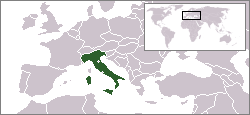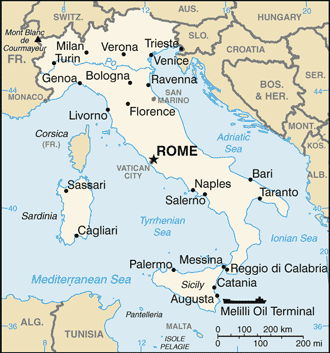Italy
| ||||
| National motto: none | ||||

| ||||
| Official language | Italian¹ | |||
| Capital | Rome | |||
| Largest City | Rome | |||
| President: | Carlo Azeglio Ciampi | |||
| Prime Minister: | Silvio Berlusconi | |||
| Area - Total - % water |
Ranked 71st 301,230 km² 2.40% | |||
| Population - Total (2004) - Density |
Ranked 22nd 57,998,353 197/km² | |||
| Unification | 17 March 1861 | |||
| GDP - Total (2003) - GDP/capita |
Ranked 6th $1.550 Trillion $26,700 | |||
| Currency | Euro (€) (²) | |||
| Time zone - in summer |
CET (UTC+1) CEST (UTC+2) | |||
| National anthem | La Canzone degli Italiani | |||
| Internet TLD | .it | |||
| Calling Code | +39 | |||
| (¹) French is co-official in the Aosta Valley; German is co-official in South Tyrol. (²) Prior to 1999: Italian Lira. | ||||
The Italian Republic or Italy (Italian: Repubblica Italiana or Italia) is a country in the south of Europe, consisting mainly of a boot-shaped peninsula together with two large islands in the Mediterranean Sea: Sicily and Sardinia. To the north, where it borders France, Switzerland, Austria and Slovenia, the country is bounded by the Alps. The independent countries of San Marino and the Vatican City are enclaves within Italian territory.
History
Main article: History of Italy
Italy's history is the most important for the cultural and social development of the Mediterranean area as a whole. The country has been host to important human activities in prehistoric times, and therefore archaeological sites of note can be found in many regions: Latium and Tuscany, Umbria and Basilicata. After Magna Graecia, the Etruscan civilisation and especially the Roman Empire that came to dominate this part of the world for many centuries, came the medieval Humanism and the Renaissance that further helped to shape European philosophy science and art. The city of Rome contains some of the most important examples of the Baroque.
The Italy of modern times became a nation-state belatedly — on March 17, 1861, when most of the states of the peninsula and the Two Sicilies were united under king Victor Emmanuel II of the Savoy dynasty, hitherto king of Sardinia, a realm that included Piedmont. The architect of Italian unification was Count Camillo Benso di Cavour, the Chief Minister of Victor Emmanuel. Rome itself remained for a decade under the Papacy, and became part of the Kingdom of Italy only on September 20, 1870, the final date of Italian unification. The Vatican is now an independent enclave surrounded by Italy, as is San Marino.
The Fascist dictatorship of Benito Mussolini that took over in 1922 led to the alliance with Germany and ultimately Italy's defeat in World War II. On June 2, 1946, a referendum on the monarchy resulted in the establishment of the Italian republic, which led to the adoption of a new constitution on January 1, 1948. Male members of the royal family were sent into exile because of their association with the fascist regime, and were only allowed to return to their country in 2002.
Italy was a charter member of NATO and the European Union, and hence joined the growing political and economic unification of Western Europe, including the introduction of the Euro in 1999.
Italy is unique in that it has always preserved its name, even under all the changes and revolutions to which it has been subjected. Every other country in Europe is now known to its inhabitants by other names than were given to it by their ancestors in the time of the Romans; but Italy continues to be the name of the country at the present day, and we have no authentic records by which we can ascertain that it ever bore any other[1].
Politics
Main article: Politics of Italy
The 1948 constitution established a bicameral parliament (Parlamento), consisting of a Chamber of Deputies (Camera dei Deputati) and a Senate (Senato della Repubblica), a separate judiciary, and an executive branch composed of a Council of Ministers (cabinet), headed by the president of the council (prime minister). The president of the republic is elected for 7 years by the parliament sitting jointly with a small number of regional delegates. The president nominates the prime minister, who proposes the other ministers (formally named by the president). The Council of Ministers (mostly, but not necessarily composed of members of parliament) must retain the confidence (Fiducia) of both houses.
The houses of parliament are popularly and directly elected by a mixed majoritarian and proportional representation system. Under 1993 legislation, Italy has single-member districts for 75% of the seats in parliament; the remaining 25% of seats are allotted on a proportional basis. The Chamber of Deputies has 630 members. In addition to 315 elected members, the Senate includes former presidents and several other persons appointed for life according to special constitutional provisions. Both houses are elected for a maximum of 5 years, but either may be dissolved before the expiration of its normal term. Legislative bills may originate in either house and must be passed by a majority in both.
The Italian judicial system is based on Roman law modified by the Napoleonic code and later statutes. A constitutional court, the Corte Costituzionale, passes on the constitutionality of laws, and is a post-World War II innovation.
Regions
Main article: Regions of Italy

Italy is subdivided into 20 regions (regioni, singular regione), of which five enjoy a special autonomous status, marked by a *:
- Abruzzo
- Basilicata
- Calabria
- Campania
- Emilia-Romagna
- Friuli-Venezia Giulia *
- Latium (Lazio)
- Liguria
- Lombardy (Lombardia)
- Marche
- Molise
- Piedmont (Piemonte)
- Apulia (Puglia)
- Sardinia (Sardegna) *
- Sicily (Sicilia) *
- Tuscany (Toscana)
- Trentino-South Tyrol (Trentino-Alto Adige) *
- Umbria
- Aosta Valley (Valle d'Aosta)*
- Veneto
All regions except Valle d'Aosta are further subdivided into two or more provinces.
Geography
Main article: Geography of Italy
Italy consists predominantly of a large peninsula with a distinctive boot shape that extends into the Mediterranean Sea, where together with its two main islands Sicily and Sardinia it creates distinct bodies of water, such as the Adriatic Sea to the north-east, the Ionian Sea to the south-east, the Tyrrhenian Sea to the south-west and finally the Ligurian Sea to the north-west.
The Apennine mountains form the backbone of this peninsula, leading north-west to where they join the Alps, the mountain range that then forms an arc enclosing Italy from the north. Here is also found a large alluvial plain, the Po-Venetian plain, drained by the Po River and its many tributaries flowing down from the Alps, Apennines and Dolomites. Other well-known rivers include the Tiber, Adige and Arno.
Its highest point is the Mont Blanc (Monte Bianco) at 4,810 m, but Italy is more typically associated with two famous volcanoes: the currently dormant Vesuvius near Naples and the very active Etna on Sicily.
Economy
Main article: Economy of Italy
Italy has a diversified industrial economy with roughly the same total and per capita output as France and the United Kingdom. This capitalistic economy remains divided into a developed industrial north, dominated by private companies, and a less developedagricultural south, with 20% unemployment. In comparison to its western European neighbours, it has a high number of small to medium sized enterprises (SMEes).
Most raw materials needed by industry and more than 75% of energy requirements are imported. Over the past decade, Italy has pursued a tight fiscal policy in order to meet the requirements of the Economic and Monetary Union and has benefited from lower interest and inflation rates and joined the Euro from its conception in 1999.
Italy's economic performance has at times lagged behind that of its EU partners, and the current government has enacted numerous short-term reforms aimed at improving competitiveness and long-term growth. It has moved slowly, however, on implementing certain structural reforms favored by economists, such as lightening the high tax burden and overhauling Italy's rigid labour market and expensive pension system, because of the current economic slowdown and opposition from labour unions.
Demographics
Main article: Demographics of Italy
Italy is largely homogeneous linguistically and religiously but is diverse culturally, economically, and politically. Italy has the fifth-highest population density in Europe at 196 persons per square kilometre. Indigenous minority groups are small. Officially recognized minority language groups are:
| Group | Population | Native language | Region |
| Sardinian | 1 269 000 | Sardinian | Sardinia |
| Friulian | 526 000 | Friulian | Friuli-Venezia Giulia |
| Tyrolean | 290 000 | German | Trentino-Alto Adige |
| Occitan | 178 000 | Occitan | Piemont, Liguria, Calabria |
| Gipsy | 130 000 | Romany | the whole country |
| Albanian | 98 000 | Albanian | southern Italy |
| Franco-Provençal | 90 000 | Franco-Provençal | Piedmont, Aosta Valley, Apulia |
| Slovenian | 70 000 | Slovenian | Friuli-Venezia Giulia |
| Ladin | 55 000 | Ladin | Trentino-Alto Adige, Veneto |
| French | 20 000 | French | Aosta Valley |
| Greek | 20 000 | Griko (Greek) | Apulia, Calabria |
| Catalan | 18 000 | Alguerese (Catalan) | Sardinia |
| Croatian | 2 600 | Croatian | Molise |
| Carinthian | 2 000 | German | Friuli-Venezia Giulia |
| Carnian | 1 400 | Friulian | Veneto |
Source: Ministero degli Interni del Governo Italiano.
Although Roman Catholicism is the majority religion (85% of native-born citizens are nominally Catholic) there are mature Protestant and Jewish communities and a growing Muslim (see: Islam in Italy) immigrant community.
Main Cities in Italy, not representing Metropolitan Areas: from the 2001-10-21 census:
Culture
Main article: Culture of Italy
Italy is well-known for its art, culture, and several monuments, among them the leaning tower of Pisa and the Roman Colosseum, as well as for its food (pizza, pasta, etc.), wine, lifestyle, elegance, design, cinema, theatre, literature, poetry, visual arts, music (notably Opera), holidays, and generally speaking, for taste.
Europe's Renaissance period began in Italy during the 14th and 15th centuries. Literary achievements, such as the poetry of Dante, Petrarch, Tasso, and Ariosto and the prose of Boccaccio, Machiavelli, and Castiglione exerted a tremendous and lasting influence on the subsequent development of Western culture, as did the painting, sculpture, and architecture contributed by giants such as Filippo Brunelleschi, Leonardo da Vinci, Raffaello, Botticelli, Fra Angelico, and Michelangelo. Modern artists include the sculptor Tommaso Geraci.
The musical influence of Italian composers Palestrina, Monteverdi, Corelli and Vivaldi proved epochal; in the 19th century, Italian romantic opera flourished under composers Gioacchino Rossini, Giuseppe Verdi, and Giacomo Puccini. Contemporary Italian artists, writers, filmmakers, architects, composers, and designers continue to contribute significantly to Western culture.
Football is the main national sport and the Italians are well known for their passion for this sport. Italy has won the Football World Cup three times: in 1934, 1938 and 1982.
Miscellaneous topics
- Amalfi coast
- List of Italian universities
- Communications in Italy
- Transportation in Italy
- Military of Italy
- Foreign relations of Italy
- Tourism in Italy
- Stamps and postal history of Italy
- Italian orders of merit
- Dishes : Spaghetti, Pizza, Pandoro, Panettone.
- Police of Italy
External links
- Presidenza della Repubblica - Official site of the Italian president (in Italian)
- Parlamento - Official site of the Italian parliament (Senate in Italian only)
- gov.it Main governmental portal (in Italian)
- Farnesina, Italian Foreign Office
- Map of Italy - Maps of Italy and its regions
- Italy - maps and weather - Maps and 6 day weather forecasts for all of Italy


